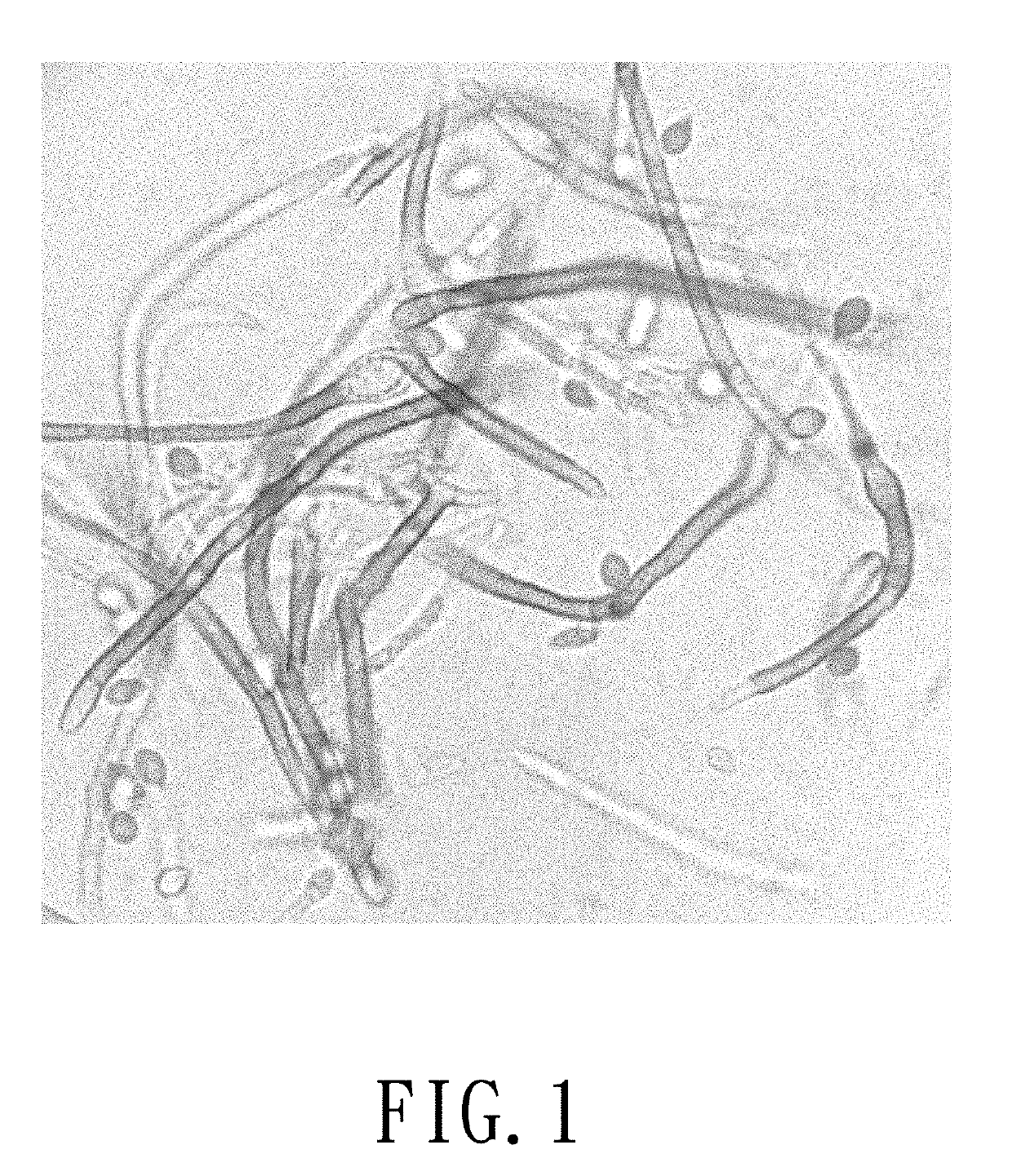Myrmecridium flexuosum nuk-21, novel lactose oxidase isolated from myrmecridium flexuosum nuk-21, and method for conversion of lactose into lactobionic acid by novel lactose oxidase
a technology of lactose oxidase and myrmecridium flexuosum, which is applied in the field of myrmecridium flexuosum nuk21, a novel lactose oxidase, can solve the problems of environmental pollution, safety concerns, and difficulty in subsequent purification, and achieves high yielding rate, high substrate specificity, and high catalytic rate
- Summary
- Abstract
- Description
- Claims
- Application Information
AI Technical Summary
Benefits of technology
Problems solved by technology
Method used
Image
Examples
experiment 1
re and Enzyme Production
[0035](1) Strain Culture
[0036]A NUK-21 strain was inoculated in a MY plate medium (containing 0.3% malt extract, 0.3% yeast extract, 0.5% peptone, 1% glucose, and 1.5% agar) at 30° C. for 3-5days. Afterwards, 2×2 cm of fungi grown in the plate medium were cut out for inoculation into a 250-ml triangular conical flask containing 5 g of wheat bran mixed with water and cultured at 30° C. for 3-5 days. After the hyphae were covered on the surface of wheat bran, 50 ml of 50 mM Tris-HCl buffer (pH 7.8) (A buffer) containing 0.2% SDS was added for enzyme extraction. The residual wheat bran was filtrated by a gauze and the filtrate was centrifuged at 12,000×g at 4° C. for 5 minutes to remove the fungi pellet. The supernatant enzyme solution was obtained and the oxidase activity was determined by peroxidase chromogen method with lactose as the substrate.
[0037](2) Solid-State Fermentation (SSF)
[0038]A NUK-21 strain was cultured in a medium containing five grains of whe...
experiment 2
ication
[0051](1) Enzyme Purification
[0052]A NUK-21 strain was incubated in a MY plate medium at 30° C. for 4 days. Afterwards, 2×2 cm of fungi grown in the plate medium were cut out for inoculation into a 250-ml triangular conical flask containing 5 g of wheat bran and 10 ml of water and cultured at 30° C. for 3-5 days. After the hyphae were covered on the surface of wheat bran, 50 ml of A buffer containing 0.2% SDS was added for enzyme extraction for 20 minutes. The residual wheat bran was filtrated by gauze and centrifuged at 8,500×g for 30 minutes to remove the fungi pellet. The supernatant enzyme solution was obtained, and the enzyme activity was measured.
[0053]Ammonium sulfate [(NH4)2SO4] precipitation, hydrophobic column Toyopearl phenyl-650M (purchased from TOSOH), HW-50 molecular sieve column (Fractogel HW-50 gel filtration; available from Merck) and Ultrogel-hydroxyapatite column chromatography (purchased from Pall Corporation) were used to obtain a relatively purified enzy...
experiment 3
cterization
[0067](1) Purity and Determination of Molecular Weight by Electrophoresis:
[0068]SDS-PAGE was carried out on 10% acrylamide slabs using the modified Laemmli buffer system (Nature 1970;227:680-5). Coomassie brilliant R-250 was used for staining. The apparent molecular weight of the purified enzyme was 47,200 Da as determined using SDS-PAGE as shown in FIG. 6. Compared with carbohydrate oxidases with similar activity, lactose oxidase has a lower molecular weight.
[0069](2) Prosthetic Group Analysis:
[0070]Oxidases usually have a coenzyme to convert or accept electrons. Riboflavins, heme, or metals (such as copper ions) are commonly coenzymes and can be detected by a visible light spectral scan. NUK-21 lactose oxidase did not show any similar signal on the VIS absorption spectrum (data not shown). The content of metals was determined quantitatively by inductively coupled plasma mass spectrometry (ICP-MASS). The enzyme was found to contain 2 mol of Zn / mol of enzyme protein, and ...
PUM
| Property | Measurement | Unit |
|---|---|---|
| molecular weight | aaaaa | aaaaa |
| temperature | aaaaa | aaaaa |
| temperature | aaaaa | aaaaa |
Abstract
Description
Claims
Application Information
 Login to View More
Login to View More - R&D
- Intellectual Property
- Life Sciences
- Materials
- Tech Scout
- Unparalleled Data Quality
- Higher Quality Content
- 60% Fewer Hallucinations
Browse by: Latest US Patents, China's latest patents, Technical Efficacy Thesaurus, Application Domain, Technology Topic, Popular Technical Reports.
© 2025 PatSnap. All rights reserved.Legal|Privacy policy|Modern Slavery Act Transparency Statement|Sitemap|About US| Contact US: help@patsnap.com



